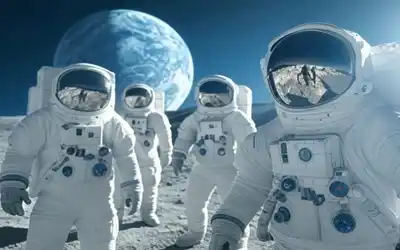
Lunar Laser Ranging experiments
During the Apollo missions 11, 14 and 15 reflectors were placed on the moon by the Apollo astronauts with the goal of measuring the distance between the surfaces of the Earth and the Moon. The principle is simple; you fire a laser from Earth to the reflector on the Moon and wait until you receive the laser back. This is called Lunar Laser Ranging (LLR). These laser reflectors are many times used by NASA enthusiasts as proof that the Apollo moon landings took place. Despite the fact that the Russians landed two robots which both carried laser reflectors, NASA insists that the Apollo laser reflectors are irrefutable proof that Apollo landed a man on the moon.
NASA's own documentation mentions that the Apollo 11 reflector did not work "immediately after the astronauts placed the reflector on the moon. At NASA they coulden't think of any reason why the Lunar reflector didn't work immediately, as stated in the Apollo mission report fron August 14, 1969(2). According to NASA documentation the Lunar reflectors were placed by the astronauts in a fixed position. The first Laser bounce was received 11 days later by the Lick Observatory's 120-inch (304-cm) telescope. This was on the 1st of August 1969, between 10:15 and 12:50 Universal Time. It is known that the Russians were able to adjust their reflectors placed by the lunar robots Lunokhod 1 and Lunokhod 2. Were the NASA reflectors also placed by robots and did NASA have to do some fine tuning before they were able to get results. This may sound like a crazy idea but did you know that the Apollo reflectors were placed within one degree of the perfect ranging angle and in a perfect triangle on the moon.
Below two press photographs of Lunokhod 1 and Apollo 11 mission Report, LLR didn't work "immediately" clipping from page 4.
Within one degree of the perfect angle
The Apollo reflectors were placed and adjusted by the astronauts within a time period of a few minutes. If that is the case than they did a hell of a job. How do you position 3 different reflectors, just by hand, within one degree of the perfect angle? This is what Tom Murphy from the "Apache Point Observatory Lunar Laser-ranging Operation" (APOLLO) project tells us. Is it not more likely that this was done by remote controlled robots. How were the Apollo astronauts able, in an unknown environment and wearing bulky suits, to position the reflectors so precisely? (1) Video
Perfect Triangle
Also stated by Tom Murphy, NASA positioned the Apollo 11, 14 and 15 reflectors in a perfect triangle. Notice how he corrects himself during his presentation: "somewhat triangular pattern... not somewhat, it is a perfect triangular pattern". What are the chances that they were positioned in a perfect triangle all within one degree of the perfect ranging angle? Would that not have been much more easily accomplished with robots like the Russians did? (1) Video
How did the Apollo astronauts place the reflectors on the moon
On the NASA website Apollo 15 documentation tells us: "A typical timeline from A-15 shows ~6 minutes for deploying the experiment". Also we are told that the reflector would be placed on a "Generally flat and level area" (page 45) for NASA documentation. (LRRR= Lunar Laser Ranging RetroReflector)(3)
"Site selection: Generally flat and level area, 300 to 500 feet due W of the LM. Greater than 500 feet was requested to minimize the dust from LM ascent.
Deploying experiment: Carried by hand (along with the PSEP on A-11) to the deployment site. The leveling leg, deployed by the astronaut by pulling a pin, provided the proper elevation angle for each site. It was tilted and then rested on the surface using the UHT. It was pointed towards the Earth. The bubble used to level the device on A-11 showed it to be within 0.5 degree of level, with the bubble oriented to the SW. A sun-compass allowed azimuthal alignment of the array with respect to the sun. After these steps, the dust cover was removed. There was no trouble deploying the A-14 or 15 LRRR, either. The operations sequence on A-15 was slightly different, but essentially the same tasks were performed. A typical timeline from A-15 shows ~6 minutes for deploying the experiment. UHT = Universal Handling Tool
Training video tells it all
Here is an Apollo training video with Neil Armstrong showing how the astronauts would place the lunar laser reflectors on the moon. There is no way that they would have been able to place these reflectors with the precision advertised by NASA. If NASA insists that the Apollo astronauts placed the reflectors on the moon then we would like to see the procedures from NASA describing exactly how the astronauts accomplished this almost perfect ranging angle in 6 minutes using only a spirit level and a sun-compass, as seen in the training video. It is much more likely that the reflectors were placed by robots who were remotely controlled from Earth, just like the Russians did.
The NASA video came without sound we have added the audio under it. We have however not altered or changed the video in anyway. Credit to NASA for video.
(1) Source Video | (2) Apollo 11 Mission Report page 4 | (3) Apollo 15 documentation |





